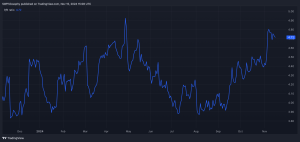A while ago I sold my Lloyds (LSE: LLOY) shares and used part of the proceeds to buy more Phoenix Group Holdings (LSE: PHNX) stock.
Approaching the end of Q3, I ran my key three stock-screening criteria to see if my decision still holds good.
Earnings growth potential
Ultimately, earnings are what powers a company’s share price and dividend higher.
In Lloyds’ case, analysts estimate that its earnings will rise by 5.1% a year to the end of 2026.
The forecasts are for Phoenix Group’s to increase by a stellar 72.9% each year to the same point.
A principal risk for Lloyds is a shrinking net interest margin as UK rates decline. This margin is the difference between interest on loans and deposits.
For Phoenix Group, a key risk is intense competition in its sector that may cause the same type of profit margin squeeze.
Overall, a win for Phoenix Group here, I think.
Relative stock valuation
On the key price-to-sales ratio (P/S) of stock valuation, Lloyds trades at 1.9 – the same as its peer group’s average. So, it is fairly valued on this basis.
Phoenix Group trades at a P/S of 0.3 compared to an average of 1.3 for its competitor group. Therefore, it looks undervalued here.
Specifically, a discounted cash flow analysis shows it to be 33% undervalued at its current £5.51. So a fair value would be £8.22, although it might go lower or higher than that.
Another win for Phoenix Group, in my view.
Dividends
In 2023, Lloyds paid a total dividend of 2.76p, which gives a current annual yield of 4.8%.
Phoenix Group paid 52.65p, generating a yearly payout of 9.6%.
£11,000 (the average UK savings amount) invested in Lloyds would make £528 a year in dividends. Over 10 years on the same rate, it would be £5,280, and after 30 years £15,840.
The same amount invested in Phoenix Group would give £1,056 a year on its 9.6% yield. On the same average rate, it would be £10,560 after 10 years, and £31,680 after 30 years.
This big returns gap widens even more if the dividends are used to buy more of each of the stocks (‘dividend compounding’).
After 10 years of doing this (on the same 4.8% average yield), the Lloyds investment would have made an extra £6,760. After 30 years, it would have added £35,295.
However, the Phoenix Group investment (on the same 9.6% average yield) would have generated an additional £17,619 after 10 years. And after 30 years, an additional £182,724 would have been made.
So, a third win out of three in my book for Phoenix Group Holdings.
Am I happy with my decision?
Consequently, I am extremely pleased I made the decision I did and would do the same again today.
Indeed, I intend to buy more Phoenix Group stock very soon, which I see as a prime ultra-high-yield stock.
Analysts estimate that its yield will rise to 9.9% by the end of this year. Further gains to 10.2% and then 10.5% are predicted, respectively, for 2025 and 2026.
For Lloyds, the forecasts are for a 5.3% yield this year, 5.6% in 2025, and 6.6% in 2026.
This post was originally published on Motley Fool







